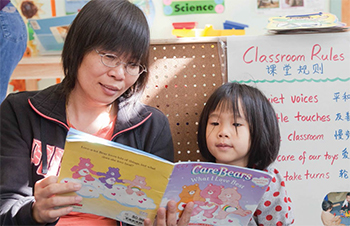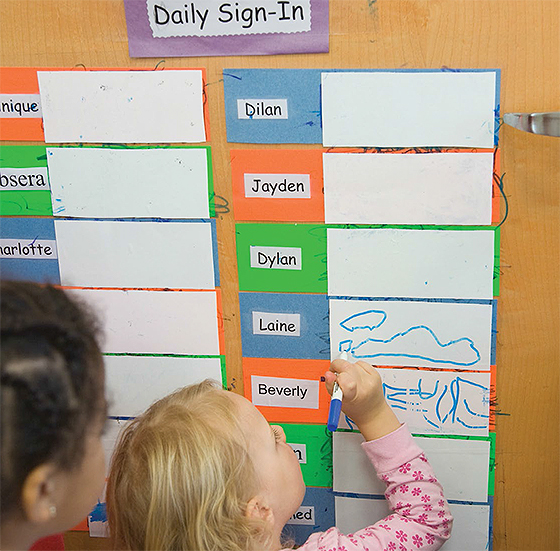Domain: Literacy
Sub-Domain: Phonological Awareness
Goal P-LIT 1. Child demonstrates awareness that spoken language is composed of smaller segments of sound.
| Developmental Progression | Indicators | ||
|---|---|---|---|
| 36 to 48 Months | 48 to 60 Months | By 60 Months | |
| Shows rote imitation and enjoyment of rhyme and alliteration. With support, distinguishes when two words rhyme and when two words begin with the same sound. | Demonstrates rhyme recognition, such as identifying which words rhyme from a group of three: hat, cat, log. Recognizes phonemic changes in words, such as noticing the problem with "Old McDonald had a charm." Is able to count syllables and understand sounds in spoken words. |
| |
Sub-Domain: Print and Alphabet Knowledge
Goal P-LIT 2. Child demonstrates an understanding of how print is used (functions of print) and the rules that govern how print works (conventions of print).
| Developmental Progression | Indicators | ||
|---|---|---|---|
| 36 to 48 Months | 48 to 60 Months | By 60 Months | |
| Distinguishes print from pictures and shows an understanding that print is something meaningful, such as asking an adult "What does this say?" or "Read this." | Begins to demonstrate an understanding of the connection between speech and print. Shows a growing awareness that print is a system that has rules and conventions, such as holding a book correctly or following a book left to right. |
| |
Goal P-LIT 3. Child identifies letters of the alphabet and produces correct sounds associated with letters.
| Developmental Progression | Indicators | ||
|---|---|---|---|
| 36 to 48 Months | 48 to 60 Months | By 60 Months | |
| Shows an awareness of alphabet letters, such as singing the ABC song, recognizing letters from one's name, or naming some letters that are encountered often. | Recognizes and names at least half of the letters in the alphabet, including letters in own name (first name and last name), as well as letters encountered often in the environment. Produces the sound of many recognized letters. |
| |
Sub-Domain: Comprehension and Text Structure
Goal P-LIT 4. Child demonstrates an understanding of narrative structure through storytelling/re-telling.
| Developmental Progression | Indicators | ||
|---|---|---|---|
| 36 to 48 Months | 48 to 60 Months | By 60 Months | |
| With support, may be able to tell one or two key events from a story or may act out a story with pictures or props. | Retells two or three key events from a well-known story, typically in the right temporal order and using some simple sequencing terms, such as first … and then. |
| |
Goal P-LIT 5. Child asks and answers questions about a book that was read aloud.
| Developmental Progression | Indicators | ||
|---|---|---|---|
| 36 to 48 Months | 48 to 60 Months | By 60 Months | |
| Can answer basic questions about likes or dislikes in a book or story. Asks and answers questions about main characters or events in a familiar story. With modeling and support, makes predictions about events that might happen next. | With support, provides basic answers to specific questions about details of a story, such as who, what, when, or where. With support, can answer inferential questions about stories, such as predictions or how/why something is happening in a particular moment. |
| |
 The home languages of some children use non-alphabetic writing. The home languages of other children may not have a written form. These children would not be expected to identify letters of the alphabet or produce corresponding sounds in their home language.
The home languages of some children use non-alphabetic writing. The home languages of other children may not have a written form. These children would not be expected to identify letters of the alphabet or produce corresponding sounds in their home language.Sub-Domain: Writing
Goal P-LIT 6. Child writes for a variety of purposes using increasingly sophisticated marks.
| Developmental Progression | Indicators | ||
|---|---|---|---|
| 36 to 48 Months | 48 to 60 Months | By 60 Months | |
| Engages in writing activities that consist largely of drawing and scribbling. Begins to convey meaning. With modeling and support, writes some letter-like forms and letters. | Progressively uses drawing, scribbling, letter-like forms, and letters to intentionally convey meaning. With support, may use invented spelling consisting of salient or beginning sounds, such as L for elevator or B for bug. |
| |
 Preschoolers engage in a variety of writing activities and begin to convey meaning through their increasingly sophisticated marks.
Preschoolers engage in a variety of writing activities and begin to convey meaning through their increasingly sophisticated marks.Last Updated: May 21, 2024
